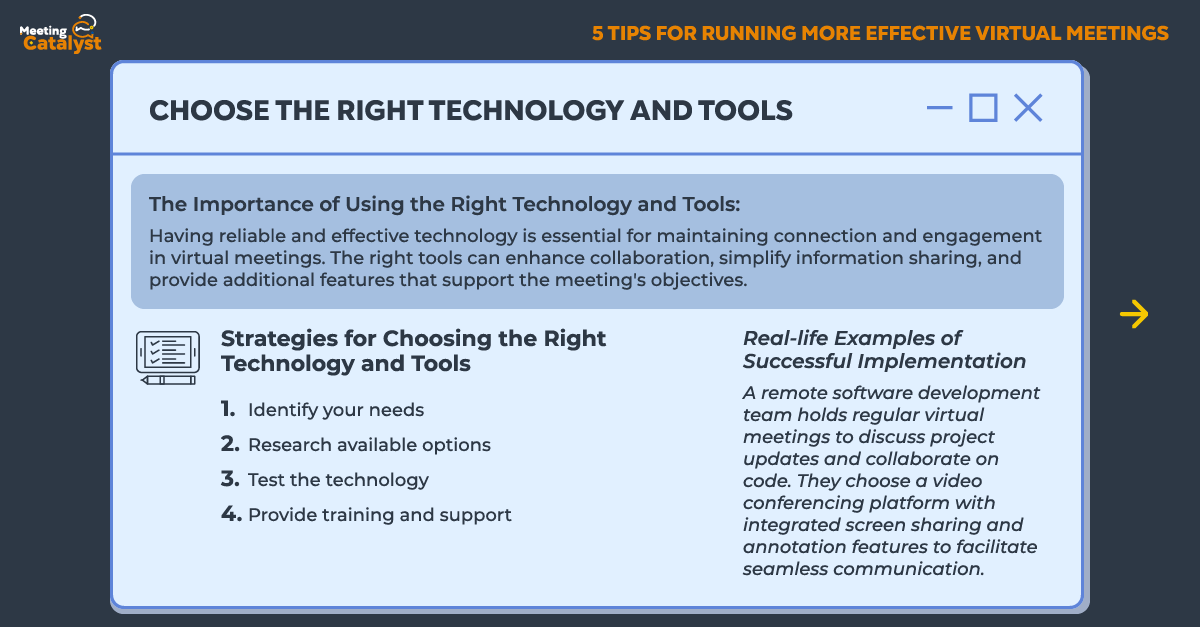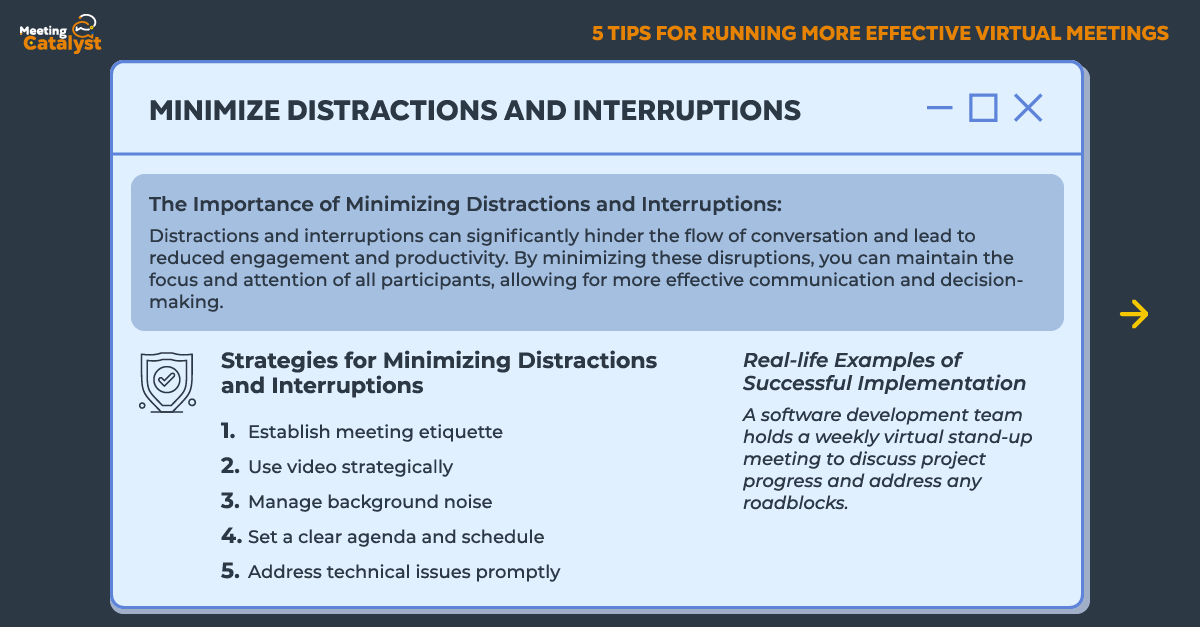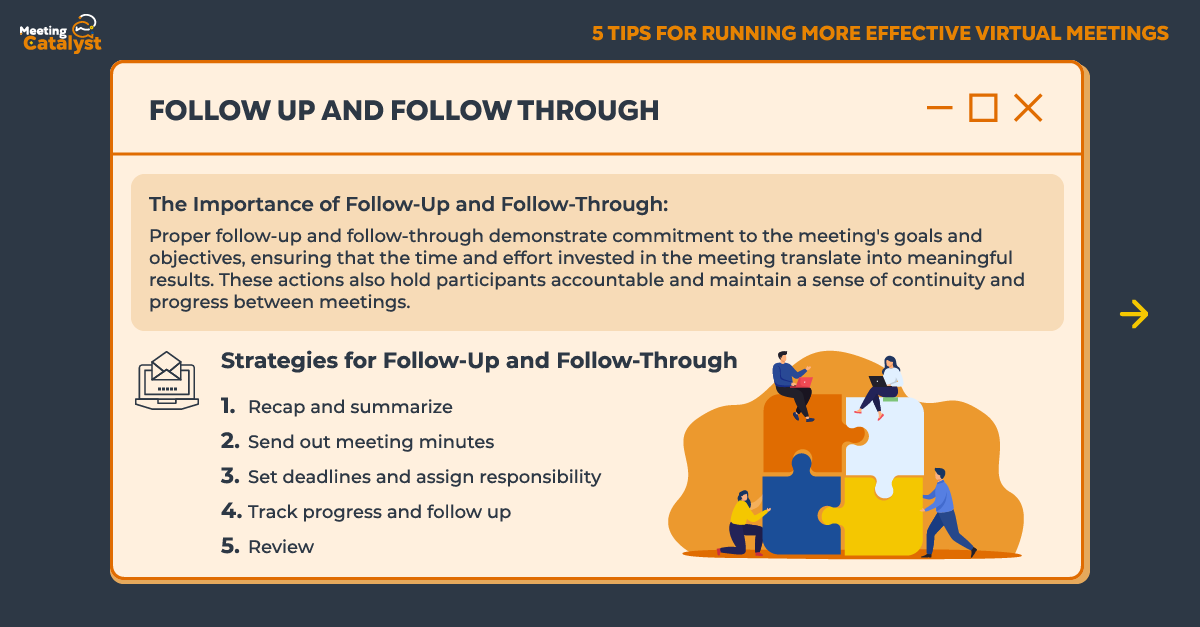5 Tips for Running More Effective Virtual Meetings

Introduction
In today's fast-paced, interconnected world, virtual meetings have become an indispensable tool for businesses and teams looking to collaborate effectively across distances. The ability to connect with colleagues and clients from anywhere, at any time, has opened up new possibilities for communication and cooperation. However, as the use of virtual meetings continues to grow, so does the need for strategies to ensure these meetings are as productive and efficient as possible. This article will provide you with five essential tips for running more effective virtual meetings, helping you maximize their potential and make the most of your time together.
The Importance of Effective Virtual Meetings
- As remote work and global collaboration become increasingly prevalent, the need for effective virtual meetings is greater than ever. Well-organized and efficient meetings can enhance team communication, boost productivity, and foster stronger relationships among participants.
Five Tips for Better Virtual Meetings
- In this article, we will explore the following five tips to help you run more effective virtual meetings:
- Establish Clear Objectives and Agendas
- Choose the Right Technology and Tools
- Engage Participants and Encourage Participation
- Minimize Distractions and Interruptions
- Follow Up and Follow Through
By implementing these strategies, you can create a virtual meeting environment that promotes engagement, collaboration, and productivity, while also minimizing the common challenges associated with remote communication. Read on to discover how you can take your virtual meetings to the next level.
Establish Clear Objectives and Agendas

A well-structured virtual meeting begins with clearly defined objectives and a comprehensive agenda. Establishing these elements in advance helps participants understand the purpose of the meeting, sets expectations, and enables them to come prepared to contribute effectively.
The Importance of Clear Objectives and Agendas
- Having a clear understanding of the goals and topics to be discussed during a virtual meeting is crucial for maintaining focus and ensuring that time is used efficiently. It also allows participants to prioritize their contributions and allocate time for discussion and decision-making.
Strategies for Setting Objectives and Agendas
- To create a successful virtual meeting, consider the following strategies when setting objectives and preparing an agenda:
- Define specific, measurable goals for the meeting: Identify the desired outcomes and what you hope to achieve by the end of the session.
- Break down objectives into smaller, actionable items: This helps to structure the meeting and provides a clear roadmap for participants to follow.
- Create a detailed agenda: Outline the topics to be discussed, the order in which they will be addressed, and allocate time for each item.
- Share the objectives and agenda in advance: Distribute this information to all participants before the meeting, allowing them to prepare and gather any necessary resources or materials.
By establishing clear objectives and agendas for your virtual meetings, you can ensure that participants are engaged and focused, ultimately leading to more effective and efficient discussions.
Choose the Right Technology and Tools

In virtual meetings, the technology and tools used have a significant impact on the overall success of the meeting. Selecting the appropriate tools not only enhances communication but also ensures a seamless and user-friendly experience for participants.
The Importance of Using the Right Technology and Tools
- Having reliable and effective technology is essential for maintaining connection and engagement in virtual meetings. The right tools can enhance collaboration, simplify information sharing, and provide additional features that support the meeting's objectives.
Strategies for Choosing the Right Technology and Tools
- To optimize your virtual meetings, consider the following strategies when selecting technology and tools:
- Identify your needs: Determine the specific requirements of your meeting, such as video conferencing, screen sharing, or real-time document editing.
- Research available options: Compare various platforms and tools based on features, cost, ease of use, and compatibility with your organization's existing systems.
- Test the technology: Before implementing a new tool, trial it with a small group to ensure it meets your needs and to identify any potential issues.
- Provide training and support: Ensure that all participants are comfortable using the chosen technology by offering training and resources as needed.
Investing time and effort in choosing the right technology and tools for your virtual meetings will create a more engaging and productive environment for all participants. By understanding your meeting requirements and thoroughly researching available options, you can select the most suitable tools to support your virtual meeting goals.
Engage Participants and Encourage Participation

A vital component of successful virtual meetings is engaging participants and fostering an environment that encourages active involvement. By involving everyone in the discussion, you can create a more dynamic and productive meeting experience.
The Importance of Engaging Participants and Encouraging Participation
- In virtual meetings, it can be challenging to maintain the same level of connection and interaction as in-person gatherings. Encouraging active participation helps to prevent disengagement, fosters open communication, and ensures that diverse perspectives are considered.
Strategies for Engaging Participants and Encouraging Participation
- To promote active involvement in your virtual meetings, consider implementing the following strategies:
- Set expectations: Clearly communicate that participation is valued and expected from all attendees.
- Assign roles: Designate roles such as timekeeper, note-taker, or discussion leader to create a sense of responsibility and involvement.
- Use icebreakers or warm-up activities: Start the meeting with an engaging activity to create a comfortable and relaxed atmosphere.
- Encourage questions and comments: Regularly pause to invite input and feedback from participants, ensuring that everyone has an opportunity to contribute.
- Utilize interactive features: Take advantage of tools such as polls, breakout rooms, or shared whiteboards to encourage collaboration and interaction.
- Provide opportunities for small group discussions: Breakout rooms can facilitate more in-depth discussions and help quieter participants feel more comfortable sharing their thoughts.
Fostering engagement and encouraging active participation in virtual meetings helps ensure that all voices are heard and contributes to a more effective and dynamic meeting experience. By implementing these strategies, you can create an inclusive and collaborative virtual meeting environment.
Minimize Distractions and Interruptions

Effective virtual meetings require focus and concentration, making it essential to minimize distractions and interruptions. By creating a meeting environment that fosters attentiveness and minimizes potential disruptions, you can ensure a more productive and efficient virtual meeting experience.
The Importance of Minimizing Distractions and Interruptions
- Distractions and interruptions can significantly hinder the flow of conversation and lead to reduced engagement and productivity. By minimizing these disruptions, you can maintain the focus and attention of all participants, allowing for more effective communication and decision-making.
Strategies for Minimizing Distractions and Interruptions
- To reduce distractions and interruptions in your virtual meetings, consider implementing the following strategies:
- Establish meeting etiquette: Set expectations for behavior during the meeting, such as muting microphones when not speaking, turning off notifications, and avoiding multitasking.
- Use video strategically: Encourage participants to use video to promote engagement, but allow flexibility for those who may need to turn off their cameras due to connectivity issues or other concerns.
- Manage background noise: Encourage participants to use noise-cancelling headphones or find a quiet space to reduce background noise and prevent interruptions.
- Set a clear agenda and schedule: Provide an outline of the topics to be discussed and allocate time for each item, helping to maintain focus and prevent off-topic conversations.
- Address technical issues promptly: Encourage participants to test their equipment and connections before the meeting, and have a designated person available to help troubleshoot any technical difficulties that may arise.
Minimizing distractions and interruptions is a crucial aspect of running effective virtual meetings. By implementing these strategies, you can create a more focused and attentive environment, leading to better communication, decision-making, and overall meeting outcomes.
Follow Up and Follow Through

A successful virtual meeting doesn't end when the call disconnects. Ensuring proper follow-up and follow-through is essential for maintaining momentum and achieving desired outcomes. By taking the time to review key points, assign tasks, and track progress, you can drive success and maximize the effectiveness of your virtual meetings.
The Importance of Follow-Up and Follow-Through
- Proper follow-up and follow-through demonstrate commitment to the meeting's goals and objectives, ensuring that the time and effort invested in the meeting translate into meaningful results. These actions also hold participants accountable and maintain a sense of continuity and progress between meetings.
Strategies for Follow-Up and Follow-Through
- Implement the following strategies to enhance the effectiveness of your virtual meetings through follow-up and follow-through:
- Recap and summarize: At the end of the meeting, briefly recap the key points, decisions made, and tasks assigned. This helps solidify the information and ensures everyone is on the same page.
- Send out meeting minutes: Distribute a summary of the meeting, including important points, decisions, and action items, to all participants shortly after the meeting. This serves as a reference and a reminder of the tasks and responsibilities assigned.
- Set deadlines and assign responsibility: Clearly outline the tasks to be completed, the responsible individuals, and the deadlines for completion. This helps maintain accountability and encourages timely action.
- Track progress and follow up: Regularly check in with participants to monitor progress on assigned tasks and offer support or guidance as needed. This can help keep projects on track and address any potential issues before they escalate.
- Review
Conclusion
As virtual meetings become more prevalent in today's world, it's important to run them effectively to ensure successful outcomes. In this post, we covered five tips for running more effective virtual meetings.
Firstly, establishing clear objectives and agendas can help facilitate effective virtual meetings. Secondly, choosing the right technology and tools is crucial for seamless virtual meetings. Thirdly, engaging participants and encouraging participation can lead to more effective virtual meetings. Fourthly, minimizing distractions and interruptions can improve virtual meeting outcomes. Finally, follow-up and follow-through are critical components of successful virtual meetings.
Implementing these tips can help improve virtual meeting practices and ensure successful outcomes. Remember to establish clear objectives, choose the right technology, engage participants, minimize distractions, and follow up and follow through. By doing so, you can run more effective virtual meetings that lead to productive outcomes.